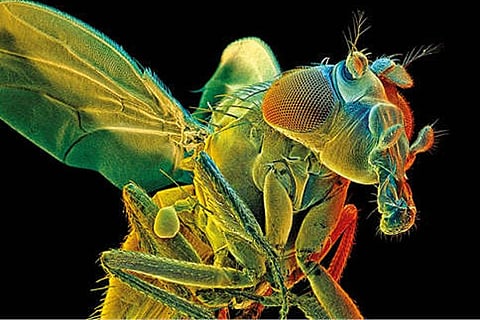

New York
The brain of a fruit fly is the size of a poppy seed and about as easy to overlook. “Most people, I think, don’t even think of the fly as having a brain,” said Vivek Jayaraman, a neuroscientist at the Janelia Research Campus of the Howard Hughes Medical Institute in Virginia. “But, of course, flies lead quite rich lives.” Flies are capable of sophisticated behaviours, including navigating diverse landscapes, tussling with rivals and serenading potential mates. And their speck-size brains are tremendously complex, containing some 100,000 neurons and tens of millions of connections, or synapses, between them.
Since 2014, a team of scientists at Janelia, in collaboration with researchers at Google, have been mapping these neurons and synapses in an effort to create a comprehensive wiring diagram, also known as a connectome, of the fruit fly brain. The work, which is continuing, is time-consuming and expensive, even with the help of state-of-the-art machine-learning algorithms. But the data they have released so far is stunning in its detail, composing an atlas of tens of thousands of gnarled neurons in many crucial areas of the fly brain.
And now, in an enormous new paper, being published on Tuesday in the journal eLife, neuroscientists are beginning to show what they can do with it. By analysing the connectome of just a small part of the fly brain — the central complex, which plays an important role in navigation — Dr. Jayaraman and his colleagues identified dozens of new neuron types and pinpointed neural circuits that appear to help flies make their way through the world. The work could ultimately help provide insight into how all kinds of animal brains, including our own, process a flood of sensory information and translate it into appropriate action.
It is also a proof of principle for the young field of modern connectomics, which was built on the promise that constructing detailed diagrams of the brain’s wiring would pay scientific dividends. “It’s really extraordinary,” Dr. Clay Reid, a senior investigator at the Allen Institute for Brain Science in Seattle, said of the new paper. “I think anyone who looks at it will say connectomics is a tool that we need in neuroscience — full stop.” The only complete connectome in the animal kingdom belongs to the humble roundworm, C. elegans. The pioneering biologist Sydney Brenner, who would later go on to win a Nobel Prize, started the project in the 1960s. His small team spent years on it, using coloured pens to trace all 302 neurons by hand.
“Brenner realised that to understand the nervous system you had to know its structure,” said Scott Emmons, a neuroscientist and geneticist at Albert Einstein College of Medicine, who later used digital techniques to create new C. elegans connectomes. “And that’s true across biology. Structure is so important.” Brenner and his colleagues published their landmark paper, which clocked in at 340 pages, in 1986. But the field of modern connectomics did not take off until the 2000s, when advances in imaging and computing finally made it feasible to map the connections in larger brains. In recent years, research teams have started assembling connectomes of zebrafish, songbirds, mice, humans and more.
Last year, researchers published the connectome for what they called the “hemibrain,” a large portion of the central fly brain, which includes regions and structures that are crucial for sleep, learning and navigation. “It’s a dramatic scaling up,” said Cori Bargmann, a neuroscientist at the Rockefeller University in New York. “This is a tremendous step toward the goal of working out the connectivity of the brain.”
Anthes is a journalist with NYT©2021
The New York Times
Visit news.dtnext.in to explore our interactive epaper!
Download the DT Next app for more exciting features!
Click here for iOS
Click here for Android